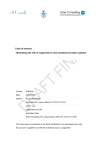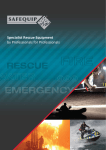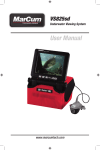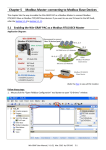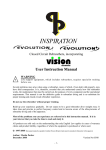Download GUE UK Wetnotes - October 2012
Transcript
WETNOTES OCTOBER 2012 ISSUE 11, OCTOBER 2012 From the Editor Class Report – Fundamentals, by Andy Clarke News – What’s going on in GUE Project Baseline – Feature on Strangford Lough by Kerri Clarke Under the Microscope – Recreational 3, by James Sanderson In the Spotlight – GUE Instructor, Gareth Burrows What’s on – 2012 dates for your diary An Audience with – Paul Burgess From the Logbook – What have you been up to? And Finally… Divers decompress after some great diving in the Shetlands. © Gareth Lock, www.imagesoflife.co.uk From the Editor Christine Grosart Welcome to the October edition of Wetnotes! In July this year I drove down to Portland, Dorset to collect some kit and popped over to Chesil Cove for five minutes on the beach and to take some photos, as you do. I was stunned and horrified by what I saw. Despite numerous beach cleans, Chesil Cove was littered with plastics, fishing nets, debris of all kinds – you name it. It is a sad, throwaway world we live in. Disgusted, I organised a beach clean-up and on 11th www.gue-uk.com August some friends and I – supported by the Marine Conservation Society, Portland Ranger, Weymouth and Portland Council and the Crown Estate – collected over ten bags of litter – including a sharps bin full of syringes and fishing hooks. The beach was a much nicer place to be at the end of the day, but there is still more work to do and with every storm, the cycle starts again. We, as divers, are guardians of the sea – it is our playground and we are responsible for looking out for it – regardless of how the litter got there in the first place. I will be organising several beach cleans in the future and I look forward to seeing as many of you there as possible. 1 WETNOTES OCTOBER 2012 The Fundamental Thing… Andy Clarke When I coined the term "GUE Fundamentalist" I thought it was rather clever. In hindsight, it merely conjures up images of a shady individual boarding an aeroplane with sticks of dynamite strapped to their chest, secured with Halcyon webbing. What I am actually referring to is that I have recently become a member of the Tufty Club, having successfully completed my GUE Fundamentals class, under the rather expert tutelage of Rich Walker. Not content with simply taking the course, I also posted my experience on my Blog (I Are Diver). This has drawn all sorts of lovely attention, feeding my narcissistic tendencies even more than usual. However, there was a price. My activities drew the watchful eye of the editor of this splendid magazine and so I ended up duct tapped to a chair, subject to incessant water boarding, in the hope I would crack and write her an article. In a final act of desperation to save myself, this was the best I could come up with. Rather than bore everyone with a further description of a GUE-F class that most of you will probably have experienced anyway, I thought I would express what I personally got out of my "Fundies" adventure. “Hello, my name is Andy and I am a GUE Fundamentalist…” Praise is all very well, but the primary factor related to my new found skill level is that diving is easier. I never found diving difficult per se, but I don't have the same panic reaction now when I get physically close to something in the water. I can fin right up to nudibranchs, without the fear of squishing them with a blue hand of death. This in turn as enabled me to finally get a photograph, in focus no less, of something smaller than a bus. I can even back kick away when I'm too close. My confidence has taken a huge boost. I'm a cautious person by nature, and my diving progression has been very slow, perhaps making me a less confident diver. I know that I have learned from one of the finest instructors out there and if he says I'm fit to go diving - I bloody well am. I'm not about to attempt a 200m cave exploration dive, I simply haven't got the time, but I am very happy in my current 45m range, knowing I possess the ability to solve any problems that may arise in a controlled manner. “I'm better at diving.” I know it's an obvious one, but it's true. My first dive after Fundies felt very different from the last one before it. Ohhhh, how profound... It's not only that I noticed it, but other divers have too. Both my wife Kerri (she took the course with me) and I have received numerous complements from other divers of late. It is immediately clear when a diver has an understanding of buoyancy, trim and positioning within the water column - it would appear I am now one of those divers. Fab! www.gue-uk.com On a grander scale, I really enjoyed the GUE experience. I have completed courses with other agencies, but I always felt the relationship ended once the bill was paid. This hasn't been the case with GUE. It is possibly due to the fact the organisation is relatively small, but the experience felt more personal and I have become part of something, rather than simply paying a fee. Both Kerri and I joined GUE upon our return, and are even considering a Project Baseline thingy. 2 WETNOTES OCTOBER 2012 We both really enjoyed the conservation stuff Rich chatted about, and left with a yearning to get more involved and maybe give something back. We'll see how that turns out. We do tend to get a little hyperenthusiastic about things! The education was fantastic. The course materials were great, and it is wonderful to have a resource I can refer back to. An additional bonus is that Rich is our new best mate. Well, not quite but he made it clear he would continue to offer advice and support when we needed it. He even volunteered to come and dive Ireland with us when we get our Project Baseline in place. I thought that was super cool. In conclusion, GUE-F was brill. It was a huge amount of fun and I learned a ton of new stuff. It has definitely added a new perspective to my diving, which has led me to enjoy the underwater world all the more. The end. Can I leave now? Get in touch: For more information about GUE Fundamentals, contact any of the instructors in the list at the end of this newsletter and they will be happy to help. Or you can read up on the class here: http://www.globalunderwaterexplorers.org/conte nt/gue-fundamentals www.gue-uk.com 3 WETNOTES OCTOBER 2012 NEWS Project Tiger is in its third year and 2012 didn’t disappoint! The 2012 team was truly international, with divers from Hungary and Germany and the weather was kind, allowing 4 diving days out of 5. The team kept a Blog throughout the week, where they dived both the stern and bow sections of the ill-fated LST 507 (Landing Ship for Tanks). The team were also treated to a presentation by Richard Bass, who was involved in a recent Channel 5 documentary about Exercise Tiger. Many thanks to Smudge at Scimitar for his support. For the Blog and more info: http://gueprojecttiger.blogspot.co.uk/ Documentary: http://www.channel5.com/shows/revealed/episodes/the-secret-d-day-scandal-revealed Project Tiger Facebook page: http://www.facebook.com/?ref=home#!/ProjectTiger1944 Divers kit up for LST 507 The team with Richard Bass Dorota Czerny points out ammo, by G.Lock Chris Grosart and friends showed up for a Chesil Cove beach clean, removing over 10 bags of waste. Items included sanitary towels, lots of fishing line, beer cans, disposable BBQs, fishing hooks, rubber piping, dummies, crisp and sweet wrappers, plastic bottles and a coat – found underwater by divers! If you are interested in joining a beach clean, contact the MCS who will be happy to help you join in or organise one of your own at a beach near you. Chris is now a Beach Clean Organiser through the MCS and is representing Global Underwater Explorers at Chesil Cove beach cleans. www.gue-uk.com 4 WETNOTES OCTOBER 2012 Kerri Clarke Project Baseline is a GUE initiative, encourage divers to visit their favourite dive sites regularly to monitor potential changes in the environment. GUE now has a dedicated person at the helm of Project Baseline, Vanessa Belz, who is on hand to help divers set up their projects and incorporate them into Google Earth spreadsheet mapper to create place marks in their chosen area. The project uses tools such as Spreadsheet mapper, Picasa, YouTube and Blogger to report sightings, add data in the form of photos, videos, narrative reports, hydrologic and biological. A great example can be seen at Wakulla Springs, the flagship and demonstrative project (http://projectbaseline.org/wakullasprings). UK divers are beginning to get involved, so the editor interviewed Kerri Clarke, who is setting up one such project at Strangford Lough, Ireland. How did you hear about Project Baseline (PB)? We first heard about PB at Tekcamp 2011 when Rich Walker did a presentation on it and how divers could get involved by gathering data from their local dive sites. What was it about PB that made you get involved? Following Tekcamp we had talked a bit about starting project but were not really sure about what we would be documenting. Then in December we had some bad storms in N Ireland and when we went to dive on one of our favourite sites, The Inner Lees, we noticed some changes to the structure of the wreck but had nothing to compare it to and therefore we could not be sure what had changed. It was following this were seriously considering starting a PB in order to observe the condition of this wreck in particular which www.gue-uk.com is deteriorating at a rapid rate. It all progressed from there. Why did you choose Strangford Lough? We had several reasons for choosing Strangford Lough. It is our local dive site and provides sheltered diving all year round. The five sites we have chosen can all be accessed from the shore and are popular with local dive clubs. Hopefully this will mean others can get involved with gathering data in the future. Strangford Lough is also an area of significant biodiversity, home to over 2,000 species of marine plants and animals but unfortunately there is also a lot of human activity in the area which results in rubbish and pollution. We want to increase the public’s awareness of the marine ecosystem and the need to protect it. What is it about your PB area that is so special to you? Where do I begin!! My dad is originally from a village on the edge of Strangford Lough so he is full of stories about the Lough. I used to work as a community nurse in the villages on the shore and it was so nice to drive around such a picturesque area between calls. Andy and I also learned to dive in there and all of our dives from Open Water through to Rescue were carried out in the Lough. Being local to us we dive there nearly every week and I never cease to be amazed at the life we see there. It is a truly beautiful area, above and below the water. How did you find the set-up process when you were starting out with PB? Once we had decided on the 5 sites we were going to monitor, it was just a case of gathering information such as history of the wrecks and species typical to the Lough. Then Vanessa from GUE sent us through the spread sheet mapper in order to publish our data onto Google earth. The spread sheet mapper took us a while to get our heads 5 WETNOTES OCTOBER 2012 around because we had never used it before. It was a case of trial and error for a while before we went live but now we have a fairly good understanding of how the coding works. It was great to add information, especially photos and video, and watch the Google earth area grow. get to at least once a year. Build links with local agencies and local dive clubs, a facebook page is a great way to spread the word. Take your time when using spread sheet mapper, you will get the hang of it! Don’t be afraid to ask Vanessa or any of the other Project Managers for help. How far have you got with your Project and what do you have in place right now? We have the Google Earth layer on the go, along with the blog and facebook. We have completed the first observation dives on each of the 5 sites and have the logs, photos and video for each. We also have an overview for each site which includes some history on the three wrecks, SS Empire Tana, SV Zarina and MY Alastor. What are your next goals for 2012? A proper survey of the Inner Lees which will hopefully result in an accurate plan of the wreck and highlight the areas of damage. Work has also started on a video overview of the project in order to help Strangford Lough come to life for those who do not live in N Ireland. What are your long term plans for PB Strangford Lough? We would like to develop further links with conservation agencies, in particular the Marine Conservation Society and Northern Ireland Marine Task Force, as we would like to see Strangford Lough become a Marine Protected Area. Northern Ireland is behind the rest of the UK in its Marine Legalisation and it is important that areas of high biodiversity, such as Strangford are closely monitored and protected. Ideally if more divers were to become involved, particularly local clubs, I would like to expand on the number of sites. The Outer Lees, The Drop Off and Gun’s Island are areas of the Lough that are only accessible by boat but it would be fantastic to have regular data from these sites too. What advice would you give about setting up a Project Baseline? Don’t be put off by thinking project diving has to be difficult and technical. Sometimes the simplest dives can yield the most interesting results. Make sure it is an area that you can www.gue-uk.com 6 WETNOTES OCTOBER 2012 How have you found the support from GUE? We would have been lost without the help from Vanessa setting up our spread sheet mapper. She is very patient, especially when I dropped my laptop and accidently deleted most of the coding! It is also great to feel part of the bigger picture and see our wee project alongside the WKPP on the Project Baseline website. The GUE community have showed a real interest in what we are doing and this is very encouraging. How is the data collection coming along? Are you finding anything interesting so far? There are a lot of beasties in Strangford Lough! On average we are recording at least 20 different species on each dive. It is staggering. Previously we only noticed the ‘bigger’ creatures such as the congers. Now that we are recording we are seeing life that we never would have noticed before such as nudibranch and sea snails. We discovered that Leach’s spider crab are a ’priority’ species as their numbers in Strangford Lough are relatively unknown. We have been seeing dozens of them for years in Ringhaddy Sound but never paid any real attention because we were not aware of the species never mind their status. great to come home and look at the data gathered. As the project develops further it will be interesting to see patterns that emerge and how the data is put to use. Thanks for supporting Project Baseline: Strangford Lough, if anyone is ever in Northern Ireland please don’t hesitate to contact us if you want to dive any of the sites. For further information on the project please email us at: [email protected] Vanessa Belz is the dedicated program manager for GUE Project Baseline and she is at the forefront of the project, organising regular webinars, meetings between site managers and working hard to make sure that volunteers, such as Kerri, get all the help and support they need. You can contact [email protected] Vanessa by email: If you would like to start your own project, you can download a user manual from the ‘How does it work’ section of the Project Baseline website. To view current projects, download Google Earth. Then go to the PB website and choose from ‘Projects’ – save the KMz file and open it with Google Earth. What are you learning by getting involved with the project (new skills, fish ID, noting litter/pollution, etc.)? Our photography and videography skills have definitely improved. I am trying to be as specific as I can with identification of species in order to provide the best data to external agencies. It is great to be able to use the buoyancy skills when taking photos or recording data. Has being involved in a project made any difference to the way you dive or think about diving? When you are diving the same sites on a regular basis you run the risk of becoming bored. Being involved in a project dive and having a ‘mission’ provides a new level to the diving. Each dive sees us recording species, clearing rubbish, taking photos and video and monitoring the state of the wrecks. It is then www.gue-uk.com 7 www.gue-uk.com 8 WETNOTES OCTOBER 2012 WETNOTES OCTOBER 2012 Under the Microscope: GUE Recreational 3 James Sanderson The GUE Recreational classes are a relatively new addition to the GUE training programme. Many divers focus on the ‘classic’ route of aiming for that golden gate ‘Tech Pass’ on Fundamentals and then the more daunting - and some feel quite large step up to Tech 1. The option of Rec 3 is being looked at by more and more divers as it can suit many of them better with regard to the type of diving they want to undertake. GUE instructor James Sanderson unravels some of this myths around this lesser used class. What do you need to take Rec 3? What is Recreational Diver level 3? It covers: ● The use of double back-gas tanks ● The use of Nitrox for decompression ● The use of Helium to minimize narcosis, CO2 accumulation and postdive 'nitrogen stress' ● The use of a single decompression cylinder for staged decompression techniques The GUE Recreational Diver level 3 course is a mastery-level recreational class, structured to prepare divers with the essential skills required for safe deeper recreational diving. Primarily this is a recreational diving course without prolonged decompression or elevated PO2. In other words, this course is not designed for those wishing to pursue a technical diving curriculum. The candidate: ● Must meet GUE General Course Prerequisites outlined in Section GUE Standards. ● Must be a minimum of 18 years of age ● A pass at GUE Rec 2 or Fundamentals Rec pass (or Tech pass) ● Must have a minimum of seventy-five non-training dives, 10 dives using doubles. This program was designed to fill the gaps in existing recreational diving and allows GUE trained divers to safely dive beyond 30m and up to the broadly accepted recreational limit of 40m. Who is Rec 3 aimed at? GUE Rec 3 is a training option for Rec 2 or Fundamentals certified divers with a recreational pass, who are committed to evolve and excel in the field of recreational diving but do not want to commit to a full technical training curriculum. This program is best related to the first few days of the Tech 1 program - but with limited failures and with the focus on valve management, precision ascents and decompression stage management. www.gue-uk.com 9 WETNOTES OCTOBER 2012 What are the limitations of the course? The course prepares divers to safely dive up to 39m (not exceeding GUE’s END and PPo2 standards and using the appropriate GUE gasses). The class encompasses the use of 21/35 or 30/30 Trimix, without more than 15 minutes of planned decompression, utilising a single decompression stage of 32% Nitrox. How long is the course and how many dives are involved? diver to high PO2. Added to this is the deadly risk of a mistaken switch at depth. The rigor in protocol and skills required to safeguard against these risks, belongs in the framework of a Tech course and not a recreational one. What topics does the course cover? Rec 3 builds on the skills and knowledge learned in previous GUE Recreational courses. Students will be introduced to the theory and practice of decompression and This is a comprehensive five-day program that involves a minimum of forty hours of instruction, encompassing nine hours of academics and eight dives. Of these dives, four will be critical skill dives and four will be experience dives What deco gases are used and why? The 32% deco bottle maintains a recreational PO2 at 21m (conventional 50% stop depth) while supporting a favourable minimum gas, allowing the diver to develop experience with deco bottles and providing a favourable ascent gas. The idea is to introduce divers to technical diving methods, including extended deco calculations, gas switching, deco-cylinder management, more advanced gas management, without exposing them to the high risk of switching to an oxygen-rich gas at depth (one of the biggest risks in tech diving). Even if a Rec 3 diver were to switch to their 32% deco cylinder at their maximum depth, their PO2 would be at a level that would make an immediate O2 toxicity scenario unlikely. Therefore, a Rec 3 diver has a large safety window (with respect to PO2) while benefiting from an increased gas supply for ascent and also gaining valuable experience should they be interested in later tech diving programs. Why isn’t oxygen being used as deco gas? Oxygen has an extremely small window of safety and can be dangerous for those without precise buoyancy skills. So, whilst introducing pure oxygen would enhance deco it also introduces more risk, exposing the www.gue-uk.com trained in correct ascent procedures. The training will include problem identification and resolution, as a means of building capacity for progressively more challenging dives. Why would these course suit recreational divers? The class enables divers to operate safely to 39m, a popular depth for wrecks in the UK, without the need to go through the rigors of a Tech 1 class. Recreational divers do not require the highly refined skills required in GUE technical diving courses and are not, in GUE's opinion, qualified to use a high PO2 gas. The aforementioned issues are not significant in recreational diving and we can reduce the required performance in areas such as buoyancy and trim as well as reduce the need for enhanced problem resolution (stress drills etc). For more information on GUE Rec 3, go to http://www.globalunderwaterexplorers.org/content/r ecreational-diver-level-3-trimix-diver 10 WETNOTES OCTOBER 2012 In the spotlight: GUE Instructor Gareth Burrows Gareth Burrows Why did you start diving? Well, I always find this embarrassing, but I started learning to dive almost exactly ten years ago, precisely 1 week AFTER returning home from Cuba. So, instead of learning to dive in the crystal clear waters of the Caribbean, drifting over one of the world’s largest coral reefs, I spent a long weekend doing fin pivots in a 7mm wetsuit in Horsea Island. Cuba had given me the incentive to get going, but I’d been dreaming about learning to Scuba dive for years. Like everyone, I thought I would be James Bond. Horsea Island soon roped that dream back into reality. What inspired you to begin teaching? I’ve always been an educator. I spent several years coaching business leaders on how to be more effective leaders. I’ve taught people everything from long distance rifle shooting to how to make Christmas pudding. It’s my passion. I love sharing knowledge, and watching others benefit. Teaching scuba diving just seemed like the most natural thing in the world to do. On my own open water course I found myself explaining the gas laws to fellow students who hadn’t got it from the instructor. I go home from every Fundies course utterly exhausted, but absolutely buzzing with excitement. What is your perfect diving day out in the UK? Blue skies, flat seas, great viz on a classic wreck. The holy trinity we are so rarely blessed with. My diving has gone shallower in the last couple of years as I like more time on the wreck and less time on the boat. So I’m diving in the 30 metre range at the moment, but with a twinset and a bottle of Oxygen, and long run times. Something like the Maine is absolutely my sweet spot, and one of my favourite dives. www.gue-uk.com How did you make the switch to GUE? Strangely I did Fundies and then carried on diving the way I used to. I still dived deep air, I still dived solo - I still pushed boundaries. The end result of this was me trapped inside a wreck at 45 metres with no torch, no buddy and no way out, watching the needle on my gauge dropping and digging hole into the ceiling in terror. After surviving that I realised I either had to give up diving, or change the way I dive to something safer. GUE wasn’t the only path I could have taken, but as I had already done Fundies and the lessons were now ringing in my brain, to adopt GUE diving practices seemed like the logical choice. Tech1 and Tech2 followed. I qualified to teach with PADI, with the intention of teaching for TDI. I was coached by Mark Powell, a great instructor. However, in the end I realised I was choosing TDI because it was the easier path. I really wanted to teach the Fundies course, but I knew the path to GUE instruction was incredibly demanding, and both time and financially painful. After months of debating with myself I realised I would never be happy teaching for anyone else, and just decided to commit. With the support of Richards Walker and Lundgren, who gave me incredible encouragement all the way, I began the long journey… What gives you the most satisfaction in your diving? Feeling in absolute control. When I am in control of myself, my buoyancy, my awareness, my equipment, then my stress levels drop to nothing and I am able to focus on looking at the wreck, the reason I have gone diving in the first place. For me, training and practice are a means to an end. I can only do so much teaching before the urge to go proper diving takes over. However, all the training and practices make the proper diving painless, and that’s when I am at my most comfortable. 11 WETNOTES OCTOBER 2012 You do a lot of coaching sessions – how do you see these benefiting the students? Well, firstly I coach a lot of people not just GUE people. However, they usually come to me for one of two reasons. Firstly, they have a specific problem that they want to resolve before a course, or that has emerged because of a course. This might be with buoyancy or trim, or perhaps they want to tidy up their propulsion techniques. People also come to me when they have new kit they want to learn how to use. The other reason people come to me is to give their skills a boost and we spend the day general pushing the confidence and levels up. For those people considering Fundies, it usually is enough to give them the confidence they need to go ahead, and of course coaching can be done in any equipment. For those people who have done Fundies, it fixes any remaining issues. It works really well, actually. What does the future hold for your own diving? One shipwreck database lists over 44,000 wrecks around the UK. That’s enough for more than one lifetime. My future does not lie in deep exploration, but shallow, personal exploration. Dives that make me grin – with ridiculous run times. In seriousness, I’ve found my ideal dive depth and type, and just aim to keep on doing it. Where do you see ambitions in the future? your teaching Well, GUE does keep dropping suggestions that they’d like to see me becoming a Tech1 Instructor, and that’s something I suspect I will investigate in the future, but for the moment I think I have the most important job in the GUE educational system. I teach fundamentals. If I do a poor job then the tech and instructors have a tougher time, and so do the students. If I do a great job then I make everyone’s life easier. So my goals at the moment are to teach the best Fundies course I can. Although we talk about standardisation, I have never taught the same course twice. People are unique, and how you communicate with them must be equally unique. My goals are to put more and more “tools in the toolbox” so that I become a more rounded instructor. www.gue-uk.com What advice would you give to GUE divers considering taking up teaching for the organisation? The path to becoming a GUE instructor is a long one, but it’s incredibly rewarding. Make sure your own skills are absolutely nailed before you begin, because you won’t be taught those skills on any course. The instructor training course does what it says on the tin – it teaches you to be an instructor, but you must be a diver first and last. You also have to understand and be prepared for the fact that there is no ready market – generating interest in GUE is half the job for a GUE instructor. Being a GUE instructor makes you a global ambassador. Everybody watches you, and everyone listens to you. That’s an awesome responsibility, but well worth the effort. How would you like to see the GUE UK diving community develop over the next few years? Growth, interaction and confidence. The community needs to grow. New GUE divers are precious things and we need to encourage them. We also need to get more involved in clubs and shops, and widen the potential audience. Interaction – we need to become more of a community. At the moment, it’s all a bit disjointed, with several small groups of divers. We need to become a true community and interact with each other far more. Basically shake things up a bit. Finally, confidence. We need to get out there and stop hiding in the shadows. We need to talk about GUE, and DIR, and stop being afraid of being labelled or demonised. We all work damn hard to be proficient, and develop high level skills. We need to remember we have the right to be proud of that. http://www.divedir.com/ 12 WETNOTES OCTOBER 2012 What’s on 2012 13th – 14th October 2012 Eurotek Diving Conference, Birmingham GUE instructors Richard Lundgren and Richard Walker will be speaking this year on wreck diving projects – come along and support them at this great event! http://www.eurotek.uk.com/index.htm 27th – 28th October Birmingham Dive Show http://www.diveshows.co.uk/dive2012/p148873-the-dive-show-of-the-year!.html 8th – 11th November 2012 GUE UK Sound of Mull – John Kendall 8th December 2012 GUE UK Xmas bash – Gareth Burrows An interview with… Paul Burgess Paul Burgess tells of broccoli quiche, basking sharks and how GUE could improve its visibility. Interview: Christine Grosart (Ed.) What is your favourite after-dive food? It’s not very manly but Scimitar’s home-made broccoli quiche was fantastic. Otherwise a super-heated pasty does the trick. What is your favourite UK dive site? There are too many to choose, but inside the SMS Koln at Scapa on a scooter takes some beating. What projects are you involved with? I have joined the Project Tiger team for the past three years, diving the LST wrecks in Lyme Bay. I very quickly came to appreciate diving with a specific task to complete and, rather than being boring, I found diving on the same site repeatedly to be very satisfying as our collective knowledge has grown. It has www.gue-uk.com 13 WETNOTES OCTOBER 2012 been great to see how divers from across Europe can instantly gel into a cohesive team. This year got even more interesting as we connected with historian Richard Bass, who has been researching the story behind Exercise Tiger for years. As GUE doesn’t have a large footprint through dive centres, most candidates will come from recommendation/word of mouth. I am sure that most existing GUE divers would already recommend Rec1 to prospective divers they know. Where do you see your diving in 5 years’ time? However to broaden the net one would need to incentivise divers from other agency backgrounds to recommend their friends train with GUE. Perhaps a referral system where the referring diver gets a decent discount on taking a GUE course. Well, I completed Cave 1 earlier this year, so starting to get to know some more caves is definitely on the agenda and we’ll see where that leads. I have also just bought a video camera and would also like to start making videos but I am totally starting from scratch. Best of all, in 5 years’ time my two boys will also be on the cusp of diving age and I am really looking forward to sharing my hobby with them (and hoping they like it). What do you think GUE UK could do to promote its existence to a wider audience? Develop film-making / photo-journalism skills amongst the membership. You need Media if you want to tell a story, especially to nondivers What do you love/hate most about UK diving? We are blessed with far more dive sites than I can ever hope to visit and I love the camaraderie on dive boats and the chance of catching supper. Being blown out is my bugbear. I need another sport which thrives on wind! What is the one skill you would be lost without? Drysuit mending! 2 - Wouldn’t it be great if there were local dive clubs which new divers could join, be taught to dive and then contribute to the club and be future technical and cave divers (and loyal consumers of follow-on training). This is tough as it requires a critical mass of GUE divers in one place who are prepared to form a club and bang the drum to recruit new divers. It also requires GUE instructors prepared to give up their time for a noble cause. Given the time and financial investment involved with being a GUE instructor this is a tough ask, but it would be great if GUE could do something to reduce the financial cost of becoming a Rec1 instructor and streamline the process so it could be taught on a nonprofit basis within a club environment (e.g. ITCs held locally). With so few Rec1 courses running to date, it wouldn’t be taking food off the instructor’s tables. Follow-on courses above Rec1 would then be provided at normal cost. 3 - Here’s one to stimulate an argument: GUE instructors would have to certify a Rec1 student for each Fundamentals/Tech/Cave student! Thanks to Paul for giving his time for this interview. Ed. How do you think GUE could encourage more new divers to the Rec 1 programme to begin their diving with the organisation? Some random ideas: 1 - Unless a new diver has been given specific advice from an experienced diver they know, they are probably unaware that training varies in quality and would be unable to make that distinction themselves. www.gue-uk.com 14 WETNOTES OCTOBER 2012 From the Logbook Farne Islands 4th/5th August 2012 Richard Walker, Kenni Maidment, Christine Grosart, Pete Ellwood, Anke Otto, Gareth Jones, Elaine Hill, Duncan Smith, James Sanderson, Neil Hunter, Paul Shuttleworth, Adrian Williamson, John Price. Divers: Kenni Maidment & John Price. I was invited to go and play with the grown ups in the Farnes, so I accepted and booked my accommodation swiftly and found myself tagging along with a friend, John Price. The 4th and 5th September was a mind blowing experience for my dive buddy and myself. We were taken out on a boat called ‘Glad Tidings VII’ (we were glad once we got ashore…) however it did get us to the dive site, the small Farne Islands. We were dropped off at the Knivestone wrecks. I couldn’t believe my eyes when I saw what was waiting down there! It was like a magic garden that someone had planted, there was a cornucopia of amazing plant life, the likes of which I had never seen before! Immediately I was mesmerised by the colours and shapes! I grabbed my camera and did a quick white balance and being a novice, snapped quite happily while my dear buddy kept on eye on things! There were so many sea urchins! There were ‘dead men’s fingers’, sponges, sea anemones, golden kelp and red and bright green sea weeds....I saw a lot of ‘local fish’ later discovered to be Ballan Wrasse, who were very inquisitive and happy to almost pose for me with their funny cartoonlike faces! Then we were teased by the seals that came by so quickly we hardly caught a glimpse! Our accommodation was expensive but the four poster bed was GREAT for hanging my dry suit on to dry out...well, had to make most of the facilities! The local pub was fabulous with great food and nice beer by all accounts. Day two was much the same and we were once again delighted with the beautiful www.gue-uk.com underwater environment...only this time the SEALS came to play….! BUT! My camera had misted up and I was unable to capture them during the dive....feeling gutted I decided to clip the camera away and enjoy the dive and hope that John would capture a few of the darling creatures. On our ascent I noticed that the camera lens had cleared....the seals appeared as if by magic and came to nibble fins and pose! We were both very aware that our gas was getting close to the mark and were on a stop when a seal came to see me with its little fins (paws?) crossed. It almost smiled at me and John caught that moment on camera. It then swiftly swam to toward the surface and pinged our SMB line almost giggling!!! It 15 WETNOTES OCTOBER 2012 came back to have a nibble of Johns fins and then again to see if mine tasted any better. More seals came around and swam by looking cheeky and one found a sandy area on the bottom to roll about. I could have stayed there forever....but it was finally time to get back on the boat and with a ‘whoop whoop’ I did - with those memories in my head forever....and the icing on the cake was the photos. My gratitude goes out to all the people who have helped me learn to dive properly – they know who they are - and my dear buddy for helping me to gain confidence in the water...without these people I wouldn’t have had this incredible experience! All I can say is....if you haven’t dived the Farnes, it’s an absolute must! Kenni Unknown Wreck – Malta 25th August 2012 Divers: John Kendall, Steve Sceri Depth 56m, Bottom time 25mins We believe this to be a degaussing vessel or some kind of minesweeper. Interesting features are the Steering Helm and telegraph as well as all the degaussing paraphernalia. To watch a very nice video of this unknown minesweeper, visit this link: http://www.youtube.com/watch?v=I6CCyJJ33lI&feature=g-upl www.gue-uk.com 16 WETNOTES OCTOBER 2012 Shipwreck Project – September 2012 Liam Colleran Signing up for a long weekend of unknown wreck sites is an interesting prospect. No guaranteed rusting metal, but the small enticement of finding something entirely new. In the end nothing earth shaking was discovered but we all had fun which to be honest was my goal. John & Rachel Kendall made the arrangements with Skipper Graham Knott of Wey Chieftain 4. The billing was one day at recreational depths followed by two at T1 level. The fourth day got canned due to wind (shock, horror). Day one highlights were looking for small cannon on the sea bed. I discovered that when looking hard enough every single rock starts to look suspicious … but stubbornly remains a rock. Though given my archaeology skills they could have been the Terracotta Army without me spotting it. We also got to take a scary looking tool to go digging. The excuse was finding the dimensions of a hull section; though the reality is its strangely good fun to forget about non silting techniques, get on your knees and dig in the sand with no regard for vis. It’s like regressing to being four but with a twin set. changed colour as I watched and then proceeded to change texture too. I didn’t know they could do that. Not sure I hold out much hope for this specimen though as I’m fairly sure having two divers point torches at you for two minutes indicates the ruse is up. Round up; a weekend of diving that was different enough to ensure it sticks in the memory coupled with several great dive buddies including Matt Worsley, Clemens Chaskel and special mention to Shaun Nunns & John Kendall who bicker like a married couple and kept me laughing through most of the weekend. Recommended and I look forward to the next one. Watch the video (by Clemens Chaskel): http://www.youtube.com/watch?v=V5RqUGX GGdI&feature=plcp Liam Day two was a marvellous little unidentified wreck that sank upright in 42m and then collapsed into its own hull. Apparently the bell had been found the previous year but had no name. So off we went to look for clues. Richard and co. managed to raise a large jug/urn which looked like an oversized cider jug. Meanwhile the rest went for a poke about. Poking about was not well regarded by the huge concentration of oversized Conga’s, Lobster and crab. Not being dived very much seems to have made it a haven for large crustaceans with an aggressive territorial bent…. I also discovered that large crab can jump into the deeps whilst maintaining perfect trim at all times, who knew. Our final day did not go as planned as it looked like a trawler had been through our target. Plan B was just to jump onto the Iolanthe. First time for me on this and I really enjoyed a very relaxed dive drifting over the wreck and finding a cuttle fish that www.gue-uk.com 17 WETNOTES OCTOBER 2012 Shetland Gareth Lock Shetland; what can I say other than it is a bloody way north and takes a while to get there! Although I could also say that the best way to see it and the diving is on MV Valkyrie. Not much of a surprise really, considering the reputation they have as dive boat operators! A whole bunch of us (Garf and Imogen Burrows, Graham Smith, Simon Butcher, plus some American types and a rebreather diver) went diving on MV Valkyrie from 22-28 July this year. Unfortunately the weather was pants and we lost 3 dives from 10. However, that is the risk you take when diving at the extremities of the UK! Most of the more intact wrecks are in the T1+ range but you really are playing luck against the weather, although the rewards for doing so are worth it with plenty of stuff to bring up ;) If you are a wreck nut, this probably is worth one trip, but if you are into marine life, there is loads there! www.gue-uk.com When we did go diving, it was fantastic. E49 is a WWI submarine with some great atmosphere and is very photogenic (as you can see). The Glen Isla is a 45m (ish) wreck with interesting structures bits to play about on. Again, very photogenic. The MV Fraoch Ban is a small fishing boat in 30m on white sands, which means any ambient light gets bounced back. Vis 2 years ago was good enough to see the wreck from the surface looking down, but this year we only had 1820m vis! Not much more can be said about Valkyrie other than she is going to be joined by another boat up there called Valhalla, probably in the 2014 season, but depends on whether they can plumb the Jacuzzis in… ;) I am pretty sure that Hazel and Helen do not have any weeks left for Shetland next year, and only have one space for Scapa in 2013. However, there are some slots left for 2014 in both locations. 18 WETNOTES OCTOBER 2012 All photographs in this report, courtesy of Gareth Lock © Gareth Lock, www.imagesoflife.co.uk The Farnes Gareth Jones Site: Farne Islands Boat: Glad Tidings VII Buddy - James Sanderson Weather: Good - slight mist - calm Water Temp: 12. C 4/08/12, Dive #1, 21.3m, 51mins Dive #2, 10.1m max, 53mins 05/08/12, Dive #1, 19.8m max, 61mins Dive#2, 14.9m max, 50mins After finding a site - the thick fog meant our skipper was running in circles - Day one comprised of 2 dives; the first, a broken up wreck (unknown name) with an intact boiler home of some interesting life. The headlights of many cameras were a fine addition. Dive 2 ... bit of a blank so nothing too exciting, mostly involved kelp and a seal. Pub o'clock! Day 2 was a brilliant day (shown by how much I can remember); spoilt again with the weather (and a reasonable starting time) First dive consisted a lengthy wall and ridge with lots of inland cuts which allowed us to have a squeeze into. www.gue-uk.com 19 WETNOTES OCTOBER 2012 Some stunning sponge and finger life. Badger was determined to get a bit of overhead experience by repeatedly trying to get under this rock; let’s say his manifold took a beating! Thanks to Badger for his 'direct lighting' when trying to photo some sponges 21w = over exposed! We then concluded to the shallows where I was abused by a seal with a fin fetish. LUNCH TIME! The real indication of who was from the North and from the South - Pie's Vs Hummus! Second dive consisted with a shallow start through a kelp swim through with half a dozen seals around above. Dropping down we faced a series of boilers and winches which again had some brilliant life. With an entertaining game of pin the rocks on the GUE instructor with Paul and Pete. We then returned to the shallows where we were spoilt by seal curiosity. Hovering in the shallows we were slowly drawing attention of the local seal MC who were in love with my camera flash diffuser. After a good 20mins of being the centre of attention we surfaced. Brilliant day! Overall a great weekend, meeting new divers and old friends. I look forward to the next trip. Many thank to Rich for booking and Chris for the pestering! Report and photos: Gareth Jones. www.gue-uk.com 20 WETNOTES OCTOBER 2012 Wetnotes Contributions Many thanks to all the contributors in this issue of Wetnotes: Gareth Lock, Andy Clarke, Kerri Clarke, James Sanderson, Gareth Burrows, Paul Burgess, Kenni Maidment, John Kendall, Liam Colleran, Gareth Jones. A special ‘Thank you’ to Clemens Chaskel for his help with this edition of Wetnotes. To contribute to Wetnotes, please contact Christine Grosart: [email protected] We’ll be getting messages out there via our GUE UK Facebook page: http://www.facebook.com/?ref=home#!/groups/gueuk/ We are always looking for brief dive reports, photos, class reports, conservation articles, tips and hints and exploration articles. GUE UK Instructors GUE UK Instructors Richard Walker Tel: +44 (0) 7968 966 749 Classes: Rec1, Rec2, Rec3, Fundamentals, DPV1, Tech1, Tech2 Primers: GUE, Doubles, Drysuit Email [email protected] Graham Blackmore Tel: +44 (0) 07588-757570 Classes: Fundamentals, Rec 1 Primers: GUE, Doubles, Drysuit, DPV1, Tech 1 Email: [email protected] John Kendall Tel: +44 (0) 7798 523110 Classes: Rec1, Rec3, Fundamentals, DPV1, Tech1 Primers: GUE, Doubles, Drysuit Email [email protected] Renato Raseta Tel: +44 (0) 7990 560058 Classes: Fundamentals Primers: GUE, Doubles, Drysuit Email: [email protected] Gareth Burrows Tel: +44 (0) 7876 147019 Classes: Rec1, Fundamentals Primers: GUE, Doubles, Drysuit Email [email protected] Brian Allen Tel: +44 (0) 7867 525458 Classes: Fundamentals Primers: GUE, Doubles, Drysuit Email [email protected] Osama Gobara Tel: +44 (0) 7794 179280 Classes: Rec 1 Email [email protected] James Sanderson Tel: +44 (0) 7946680271 Classes: Fundamentals Primers: GUE, Doubles, Drysuit Email [email protected] www.gue-uk.com And Finally… Congratulations to Osama Gobara on becoming a Fundamentals Instructor! Richard Walker will be giving a talk on the Thresher Shark Research and Conservation Project in Sheffield on Thursday 15th November at 7pm, for Sheffield University SAC. Contact Rich for details. http://www.threshersharkproject.org/TSRCP/Home.html Don’t forget the GUE UK Christmas bash on 8th December – contact Gareth Burrows for details. 21






















